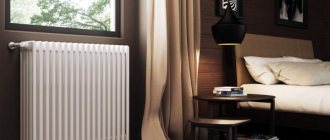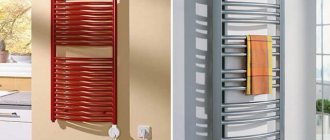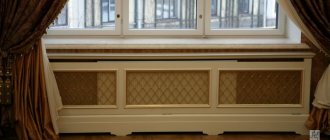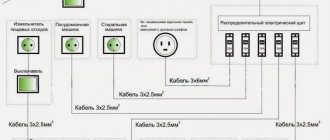Without special knowledge, you can replace a cast-iron battery with a bimetallic one in your apartment with your own hands. The service life of cast iron batteries is on average 35-40 years. In heating systems without draining water (for the summer), the period is extended to 50 years.
This means that the unreplaced Soviet fund threatens apartment owners (and downstairs neighbors) with a sudden outburst.
Experience shows that even untrained people can dismantle and install home heating appliances.
Stores offer a wide range of bimetallic batteries and accessories for installation and replacement.
Which batteries should you choose?
There are many models of radiators made from various alloys on the modern market. Each has its own positive characteristics and features of use.
Aluminum batteries
Radiators made from this material are produced in two types – cast and extruded. The former are a one-piece monolithic structure, while the latter are made of aluminum parts welded together. Leaf type batteries are more durable and reliable.
Regardless of the type, aluminum radiators have common basic technical characteristics:
- section weight – from 1 to 1.47 kilograms;
- permissible maximum coolant temperature – 110 degrees;
- product power – from 82 to 212 watts;
- the maximum liquid volume of one section is 0.46 liters;
- working pressure – from 6 to 24 atmospheres.
Batteries have been made from aluminum since the eighties. These days, the products have improved quite a bit and have not lost their popularity.
Aluminum batteries
The main advantages of aluminum heating radiators include:
- light weight of the product, facilitating its quick installation and transportation;
- high level of heat transfer due to rapid heating of the metal and the intensity of heat exchange;
- the ability to adjust the temperature even with a small volume of coolant;
- relatively low price for the product;
- good strength;
- decent appearance.
Along with the advantages, aluminum batteries have some disadvantages:
- low resistance to corrosion;
- the possibility of formation of air in the system due to the chemical process.
If we take extruded models into account, we can highlight their weak point - threaded connecting fasteners. With a sharp increase in pressure in the system, the integrity of the structure may be compromised.
Radiators made of steel
The installation of such radiators is justified in private houses with a local autonomous heating system. The peculiarity of devices of this type is:
- working pressure – from 6 to 13 atmospheres;
- The maximum water temperature in the battery is 110 degrees.
Despite their relatively low technical characteristics, steel radiators are very popular. The use of devices has the following advantages:
- compact designs;
- possibility of adjusting the temperature using a thermostat;
- high heat transfer rates;
- a wide variety of models produced;
- the cost is much lower than many new types of batteries being released.
Among the disadvantages, the most significant are:
- incompatibility with an open heating system;
- susceptibility to corrosion;
- special requirements for the quality of the coolant used.
Radiators made of steel
The presence of various chemical impurities in the liquid used in a steel battery can cause destruction of the material. In this case, coolant leakage is sometimes observed due to violations of the tightness of the connections. Therefore, steel radiators are not installed in multi-storey new buildings.
Bimetallic batteries
Radiators of this type are improved models that combine all the advantages of aluminum and steel products. The devices have earned widespread use due to their high technical characteristics:
- maximum internal working pressure – 60 atmospheres;
- heat transfer – up to 190 watts;
- maximum coolant temperature 110 degrees.
There are many advantages of using bimetallic radiators:
- long service life - up to fifty years;
- high thermal output and quick heating of the room;
- good anti-corrosion properties;
- high level of strength;
- possibility of installing additional sections;
- maximum sensitivity to thermostat commands;
- Availability of models with different design solutions.
Bimetallic batteries
The material withstands high hydraulic shocks characteristic of central heating systems.
The disadvantage of bimetallic radiators is their high price. As a rule, they are more expensive than aluminum or steel products. Cheap bimetallic batteries do not have corrosion protection, so over time, rust will form on the product.
What to do with a stuck ball valve
If ball valves are not rotated for years, they tend to sour and jam. In such a situation, do not try to resolve the issue physically and do not force the “butterfly” with pliers or a gas wrench. It is made of a brittle alloy and will probably break. Proceed like this:
- Unscrew the locking nut and remove the butterfly handle from the stem.
- On most of these valves, you will find a nut under the handle that clamps the plastic seal. Loosen it by turning the wrench half a turn. If there is no nut, go to the next step.
- Take an adjustable wrench or other device that allows you to securely grab the flats on the rod. Without applying much force, turn it as far as possible.
- When you feel resistance, turn the rod back all the way and forward again, trying to turn it a few more degrees. Work carefully and without haste!
- In this way, rotate the valve 90°, then tighten the gland nut and reinstall the handle.
An adjustable wrench can be used to firmly grasp the edges
Advice. If you have WD-40 spray lubricant in your household, apply it to the stem and wait 5-10 minutes before rotating.
Be doubly careful when turning off radiators with soured taps during the heating season. If you hurry too much and apply too much force, you will break off the metal rod or ball, and in the worst case, the valve body will burst. A stream of hot water can shoot out from the crack, which can burn you. While you go down to the basement and close the heating riser, the coolant will cause damage to the interior of the room, and you can roughly guess how much it costs to renovate the apartment now.
If you are not sure of your actions, call a plumber. More information on how to close a jammed ball valve in order to disconnect the radiators is described in the video:
How to calculate the number of sections?
In a residential area, the recommended power of heating devices per cubic meter is 100 watts. According to these readings, you can calculate the required number of radiator sections - N. For a collapsible battery, you can use a simple formula:
N=S*100/T
It is taken into account that S is the area of the heated room, and T is the value of the thermal power of one compartment, which can be taken from the passport attached to the product.
More accurate calculations can be made by having coefficients that correspond to data on the characteristics of the room:
- K1 – type of room located above;
- K2 – window features;
- K3 – distance from floor to ceiling;
- K4 – number of window openings;
- K5 – degree of wall insulation.
Taking these indicators into account, you can perform the calculation using the full formula:
N=S* K1*K2*K3*K4*K5*100/T
The thermal power rating is also affected by the battery material. The average value for cast iron radiators is 145 watts; for bimetallic and aluminum radiators this value is slightly higher.
Life time
The first mention of a cast iron battery dates back to 1857, when the famous Russian engineer Franz Sangalli made the first cast iron radiator from a piece of pipe. A special feature of his invention were protruding fins, which were used to remove accumulated heat. After some time, the appearance of the cast iron radiator changed, it took on the appearance of an accordion.
For a long time, heating devices made of cast iron were the main ones in civil and industrial buildings in Russia. One of the advantages of cast iron radiators is their long service life. According to experts, such a battery can be used for 50 years, but this requires periodic maintenance of the system. It consists of washing the sections and replacing the gaskets between the blocks.
What time of year is best to replace?
In private houses with individual heating, you can change the battery both in the summer and before the start of the heating season. For apartments the conditions are completely different.
If you dismantle the old radiator and install a new one in the summer, you will need information about the presence of water in the system. You can find out from a representative of the housing maintenance office. But at the same time, you need to take into account that you can check the correct installation and quality of heating of the battery only upon the arrival of the heating season.
What is the price
The cost of cast iron radiators will depend on the overall dimensions of the product, manufacturer and brand. The oldest model of domestic production is considered to be MC 140. A separate section of such a battery costs an average of 340 rubles per piece, the price depends on the markup of resellers and the region.
Also, cast iron batteries from foreign manufacturers (Italy, Czech Republic, Spain, Turkey) are supplied to the domestic market. Such devices differ from domestic ones in various respects. For example, the capacity of the section of the Czech Termo battery is almost two times smaller - 800 milliliters, while the domestic MS 140 holds 1.4 liters of water.
Radiator Nostalgia (retro) in the interior
The price of one section of foreign cast iron radiators in rubles is as follows:
- Brand Kiran 92/500 – from 335 rubles;
- Manufacturer Viadrus termo 500/95 – no less than 450 rubles;
- Company Nostalgia (retro) 500/180 – from 2120 rubles;
- Demrad 350 brand – no less than 400 rubles per section.
Battery replacement technology
Quite often, owners decide to replace an old cast-iron battery with a new, more modern and efficient model. Quite often, specialists are called in for this and quickly cope with the task. But since the process of dismantling and installing the radiator itself is not particularly difficult, you can do all the work yourself.
Tools and materials
To replace the battery you need the following equipment:
- special lever wrench for pipes;
- pencil;
- Bulgarian;
- level;
- hammer.
To replace cast iron batteries, do not forget the grinder.
Also, materials are used to install the new device;
- brackets;
- battery;
- taps;
- dowels
Disabling radiators without fittings
It is no secret that in most apartments to this day there are old cast iron radiators or steel convectors without any shut-off fittings, which makes it impossible to shut them off during the heating season. Moreover, according to the old heating scheme, convectors in high-rise buildings are connected to risers without straight sections - bypasses. Therefore, if an accident occurs with a coolant leak, you must act as follows:
- Try to provide some kind of container to collect hot water. If the stream flows to the side, wrap a thick cloth over the break site so that the water flows along it into a bucket.
- Call the dispatch service of your heating energy supply company and report the accident.
- While the service personnel are getting there, provide them with access to the basement, find the keys, open the door, and so on.
- Try to block the riser yourself.
While your water is flowing onto the floor, your neighbors below have a suspended ceiling turning into a bubble.
A few words about how to properly turn off the heating riser. Find in the basement the heating point of your entrance and vertical pipes embedded in a large-diameter main or into a common collector. Follow where they go to determine the emergency riser, and turn it off with a tap. Contact by cell phone someone in the household who can confirm that the geyser eruption in the apartment has stopped. If you couldn’t find your pipe, close all the valves one by one until you find the one you need.
Attention! Don't try to force yourself on basement valves that are stuck due to rust. When they cannot be closed manually, it is better to wait for a team of plumbers; they will find a way to stop the flow of coolant. Otherwise, a very awkward situation will arise when you also break the main fittings, leaving the apartment building without heat during repairs.
An example of an access heating point and connecting a riser.
It is also worth considering the question of how to shut off the radiator if it is hot in the apartment due to the service provider’s failure to comply with the temperature schedule of the boiler room. It would seem that if there are shut-off valves, the problem is solved by manually closing the taps. But after the temperature in the rooms drops, the valves will have to be opened again. This way you will get tired of turning the taps long before the end of the heating season, so you need to think about how you can adjust the heat output of the radiators. The options are:
- if possible, install a thermostatic valve on each radiator, limiting the flow of coolant and automatically maintaining the set temperature in the room;
- It is nice to cover the heating device with a blank screen with small holes if there are no shut-off valves on the connections.
Important. The ball valve is not a means of adjustment; it is intended only to completely cut off or open the passage of the coolant. In the “half closed” mode it will not give the desired effect and will fail much earlier.
Thanks to worn-out pipelines, district heating systems are notorious for dirty water that quickly clogs small passages. Therefore, ordinary valves with thermal heads will not last long here; you need to buy special valves with increased capacity, which are produced by the well-known brands Danfoss and Herz. How to install them on the connection to the radiator is shown below in the diagram and described in this material.
Radiator thermostat installation diagram
When it’s hot in an apartment in the middle of winter and there are no control valves, residents have no choice but to cover the radiator in the room with a decorative screen. The principle is simple: the radiator will heat the air inside the box, after which the intensity of heat transfer will sharply decrease due to the small difference in the temperatures of the air and the surface. That is, the coolant will give off less energy, and the amount of hot air coming out from under the screen will be limited by the size of the decorative openings. How to assemble and install a nice MDF box on a heating device is shown in the video:
Central heating system and its features
Most of the requirements that should be considered when choosing a radiator are related to the type of heating system. For example, in apartments, a centralized system is most often found, which has both its pros and cons. That is why you need to choose a heating unit, taking into account all the features:
In the central node system, heat is generated thanks to the main line that moves the coolant in a closed circle
The load can reach 16 atmospheres, which means that you need to carefully consider the technical characteristics of the battery. The coolant operates at different pressures, which creates water hammer, which affects the operational life of the battery. The water temperature is also unstable; changes can negatively affect the condition of the radiator and pipes. Very often, accidents of one kind or another occur in the heating system, so it is very important that the radiator can withstand various operating conditions. The connecting materials must be compatible with the unit in order to avoid its failure. Due to the high demands placed on the quality of batteries by the centralized heating network, it is necessary to carefully consider the options offered on the market
Due to the high demands placed on the quality of batteries by the centralized heating network, it is necessary to carefully consider the options offered on the market.
Conclusions and recommendations
- For an individual heating system in a private house, with low pressure, you can install cast iron or sectional radiators; under such conditions they will work perfectly.
- In an apartment in a high-rise building with central heating, where there is high pressure, poor-quality coolant, and water hammer is likely, it is better to use metal radiators.
- For an individual heating system with automatic temperature control, cast iron structures are not suitable due to their inertness; only bimetallic ones can be used here.
- In old “Khrushchev” buildings with low water pressure in the heating system, cast iron structures can continue to cope with the task; there is no need to replace it with bimetal.
- If there are no budget restrictions and all other operating conditions are met, then you can be guided only by aesthetic considerations and install expensive bimetallic batteries with a copper core or cast iron batteries, “retro” style, the price for one section of which reaches 2000 rubles.
Modern designs of heating systems allow an individual approach to solving the issue of home improvement, selecting equipment that meets the requirements of operating conditions, and taking into account the aesthetic and taste preferences of consumers.
bimetallic or aluminum
- turn off the heating
- drain the water from the system
- placing something supporting under the old battery, and a water container on the floor at the intended cutting location, we cut off the old radiator;
- remove it from its hinges;
- we cut the metal pipes at the same distance and cut the thread;
- we screw in the tees, from which both the bypass and the battery will go further;
- since I needed to turn on the heating if possible (it’s not summer), I first assembled a bypass. You can fill the system and turn on the heating (picture on the right);
- Next, we install ball valves on the tees, shutting off the supply to the battery itself;
- we screw the “American” ones to the taps;
- hang the battery on the wall;
- we measure the length, cut off the metal-plastic from the “American” ones to the radiator itself: from below - to the near edge of the battery, from above - to the far (the pipe will go above it);
- We screw a plug into the remaining holes of the battery from below, and an air vent from above (I prefer an automatic one. The seller gave me a compact one instead of the usual “barrel”);
- Having connected the bimetallic battery, open its taps and close the bypass tap;
- when the battery is filled with water, press the air vent float with a paper clip to help the air escape;
- ???
- PROFIT
Pipes... How much rubbish has leaked onto your Russian fingers?
The problem of cold batteries worries many owners of apartments and houses if the radiators are old. Due to age, they become clogged with such specific rubbish - black powder, which is so heavy that it is not washed out with water down the system, but settles “wherever it is,” that is, at the bottom of the radiators and along the entire length of the pipes. Although I washed the heating system with caustic soda after installing a new boiler, practice shows that dirt from the radiators does not dissolve in this rather aggressive solution. Therefore, part with your old batteries without regret!
Why did I choose bimetallic batteries rather than aluminum ones?
Arriving at a specialized plumbing store (Aqualink), I laid out my “drawing” (sketch) and began to assemble this entire “constructor”. The person in line advised against taking an aluminum baratea for a private home, saying that the water would “eat it up” over time. Instead, I recommended buying a bimetallic radiator (they are absolutely identical in appearance). It’s, of course, more expensive (10 sections cost me 8,000 versus 4,600 for a “luminka”), but I’ll have peace of mind. I’ve been wondering for a long time: should I buy Chinese? And I want it (because it’s half the price), and I inject it (who knows, maybe it will leak over time?). I took Italian. Together with all the tee corners, the purchase cost me 12,000+ wooden ones. Plus, you also need a machine for cutting threads, because metal-plastic needs to be joined to old heating pipes. I borrowed this thing (Rotenberger) for a day from a plumber I know. Naturally, thanking him for his concern. But I saved on labor costs.
How to unscrew the last piece of pipe without the penultimate one starting to unscrew
If you want to unscrew the last (outermost) piece of an old composite heating pipe (or water supply), but do not want the penultimate one to begin to unscrew, proceed as follows: I took a clamp from a thread cutting machine (Rothenberger, see above), secured it to pipe so that it rests on the floor (or a wall), I tapped it (as an option: heat it with a blowtorch) and easily unscrewed the piece of pipe I needed (or rather, now unnecessary).











